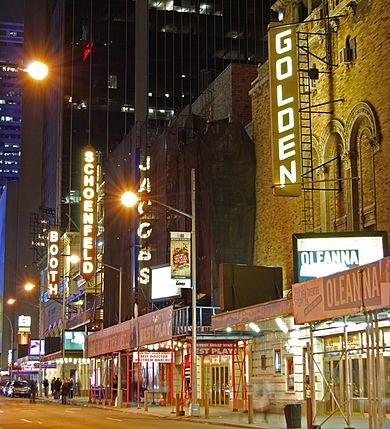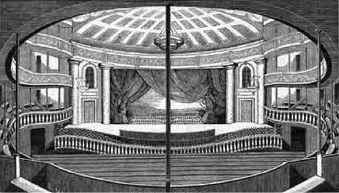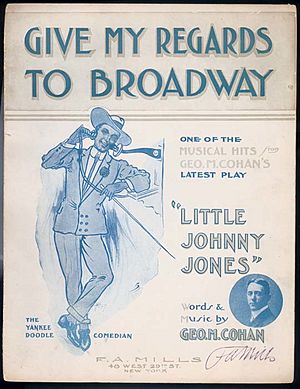Broadway theater facts for kids

Broadway theatre, or Broadway, are the theatrical performances presented in the 41 professional theatres in New York City. ("Theatre" is the British way to spell "theater" and can be used in America if it refers to a place where musicals and plays are performed.) Each theater has 500 or more seats, and they are located in the Theater District and the Lincoln Center along Broadway, in Midtown Manhattan. Only three of the theatres are located on Broadway itself: the Broadway Theatre, the Palace Theatre, and the Winter Garden Theatre.
Most Broadway shows are musicals. Smaller theaters in New York are referred to as Off-Broadway (no matter where they are located).
History
Early theatre in New York
The theater in New York began in about 1750 at the Theatre on Nassau Street, which held about 280 people. Theaters performed mostly Shakespearean plays. The Revolutionary War paused theater in New York, but it resumed in 1798. That year, the year the 2,000-seat Park Theatre was built on Chatham Street (now called Park Row). The Bowery Theatre opened in 1826, followed by others.
The Astor Opera House opened in 1847. The people who saw plays at the Bowery Theatre felt insulted that the Astor Opera House seemed to favor only the rich, and a riot called the Astor Place Riot broke out in 1849. It was then that entertainment in New York was divided among the three classes:
- Operas were for the the rich upper class.
- Minstrel shows and melodramas were for the middle class.
- Variety shows in concert saloons were for the working middle class or lower class.
Birth of the musical and post-Civil War
Looking for less expensive real estate, theatre in New York moved from downtown gradually to midtown Manhattan, beginning around 1850. Broadway's first "long-run" musical was a 50-performance hit called The Elves in 1857. More theaters were built in the years that followed.
The first theater piece that added dance and original music to help tell the story was The Black Crook. It premiered (first showed) in New York on September 12, 1866, and broke records for number of performances at 474. Tony Pastor opened the first vaudeville theatre one block east of Union Square in 1881.
In the late 1800s, transportation improved, poverty in New York declined, and street lighting helped people travel more safely at night. As a result, more people visited the theaters, and the business of theater entertainment grew. Gilbert and Sullivan's family-friendly comic opera hits, beginning with H.M.S. Pinafore in 1878, were brought to New York. A Trip to Coontown (1898) was the first musical comedy entirely produced and performed by African Americans in a Broadway theater.
Smaller vaudeville and variety houses grew quickly, and Off-Broadway was well-established by the end of the 19th century.
Twentieth century
Broadway shows installed electric signs outside the theatres. Since colored bulbs burned out too quickly, white lights were used, and Broadway was nicknamed "The Great White Way."
The invention of "silent motion pictures" followed by motion pictures with sound, the Great Depression, and two World Wars took business from the theater. It had bursts of success but remained on a steady decline. One of New York's responses COVID-19 pandemic in the United States was to close Broadway theaters on March 12, 2020. The theaters have since reopened, at first with strict regulations for cast and audience members.
Description
Typically Broadway performs eight shows in a week. They are usually in the evenings on Tuesday through Saturday with matinée (afternoon) performances on Wednesday, Saturday, and Sunday.
The majority of Broadway theatres are owned or managed by three organizations: the Shubert Organization, the Nederlander Organization, and Jujamcyn. Most Broadway producers and theater owners are members of The Broadway League, which negotiates contracts and sets the rules for Broadway.
Both musicians and actors are governed by the rules set forth by the Broadway League. For instance, a union and the league determine the number of instruments that will play during a performance. Musicals and stage plays on Broadway cast "big-name" actors, usually from movies, to bring more people to the theater.
Most Broadway shows are commercial productions intended to make a profit for the producers and investors. Usually, the investors determine ahead of time how long a show will "run," but sometimes, if ticket sales are good, they will decide to extend the show. Historically, musicals on Broadway tend to have longer runs than "straight" (i.e., non-musical) plays.
Attending a Broadway show is a common tourist activity in New York. The TKTS booths sell same-day tickets (and in certain cases, next-day matinée tickets) for many Broadway and Off-Broadway shows at a discount of 20 to 50%. This service is run by Theatre Development Fund.
To be eligible for a Tony Award, a production must be in a house with 500 seats or more and in the Theater District, which are the criteria that define Broadway theater. Extremely successful shows sometimes perform the show in other areas of the country. This is called a "Broadway national tour." Off-Broadway and Off-Off-Broadway draw audiences as well because of the different styles of plays and musicals they perform.
Interesting facts about Broadway theater
- Broadway has gone by a number of names: "Wickquasgeck trail," De Heeren Straat ("the Gentlemen’s Street"), and Brede Weg ("Broad Way" - for the width of the street).
- The theaters on Broadway increased in number from about 20 in 1900 to an all-time high of 80 in 1925.
- Lyceum Theatre was built in 1903 and is now the oldest theater on Broadway.
- When the lights of Broadway were dimmed during World War I, public demand forced the government to increase the city’s coal ration to restore the lights.
- People mistook the letter "I" for the number "1," so most Broadway theaters have rows A-H and J-Z.
- A Broadway theater must seat at least 500 people. An Off-Broadway theater seats between 100 and 499.
- The Phantom of the Opera is the longest-running Broadway show.
- The Lion King is the first in the list of the highest-grossing theater productions on Broadway.
- There are 41 Broadway Theatres in New York but despite the title, only 4 theatres are located on Broadway Street - The Winter Garden, The Roundabout, The Marquis, and The Broadway Theatre.
See also
 In Spanish: Circuito de Broadway para niños
In Spanish: Circuito de Broadway para niños



